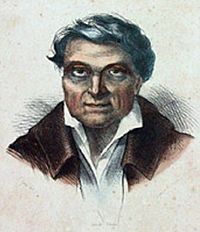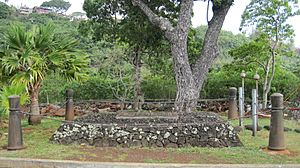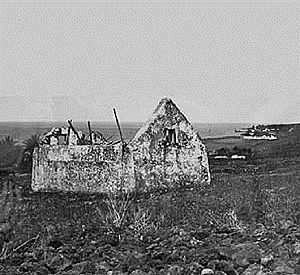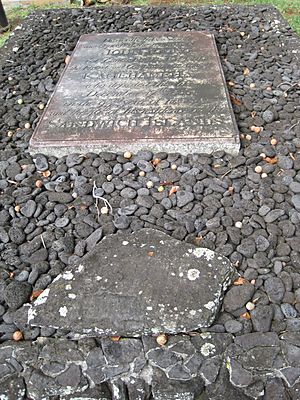John Young (advisor) facts for kids
Quick facts for kids
John Young
|
|
|---|---|
 |
|
| Royal Governor of Hawaiʻi | |
| In office 1802–1812 |
|
| Monarch | Kamehameha I |
| Succeeded by | Kuakini |
| Personal details | |
| Born | c.1742 or 17 March 1742 Crosby, England |
| Died | 17 December 1835 (aged 93) Honolulu, Oahu |
| Resting place | Royal Mausoleum of Hawaii |
| Spouses | Namokuelua Mary Kaʻōanāʻeha |
| Children | Robert Young James Kāneloa Young Fanny Kekelaokalani Grace Kamaʻikuʻi Young John Kalaipaihala Young II Jane Lahilahi Young |
| Parents | Robert and Grace Young |
John Young (born around 1742 – died December 17, 1835) was a British sailor who became a very important advisor to Kamehameha I. Kamehameha was the king who united the islands of Hawaii. Young was left behind by his ship, the Eleanora, in 1790. He and another sailor, Isaac Davis, became close friends and trusted advisors to King Kamehameha.
John Young shared his knowledge of the Western world with Kamehameha. This included new ways to fight battles on land and sea. He became a strong voice in important decisions for the Hawaiian Kingdom. He played a big part in Hawaii's first meetings with European countries. He spent the rest of his life living in Hawaiʻi. From 1802 to 1812, John Young even served as the Royal Governor of Hawaii Island. This was while King Kamehameha was away on other islands. Young also helped build a fort at Honolulu Harbor. The Hawaiian people gave him the name ʻOlohana. This name came from Young's common command, "All hands (on deck)!"
Contents
Early Life and Arrival in Hawaii
John Young was born in Crosby, England, around 1742. His father was Robert Young and his mother was Grace. He had two brothers, Peter and James. Some records say he was born on March 17, 1744.
Young worked as a boatswain, a ship's officer, on an American ship called the Eleanora. This ship was involved in trading animal furs between the Pacific Northwest and China. In February 1790, the Eleanora stopped at Kealakekua Bay on Hawaii Island. Young went ashore to look for another ship that had gone missing. However, King Kamehameha's forces had attacked the missing ship. Kamehameha did not want Young to find out, so he kept Young on the island. The Eleanora waited for two days but eventually sailed away without him. This is how John Young came to live in Hawaii. He soon met Isaac Davis, who was the only survivor from the missing ship.
Advisor to King Kamehameha I
John Young and Isaac Davis became key advisors to King Kamehameha. They taught him about Western military tactics and technology. This knowledge was very helpful in Kamehameha's efforts to unite the Hawaiian Islands.
Military Contributions
In important battles, like the Battle of Nuʻuanu, John Young was in charge of the cannons. This battle was when Kamehameha's army conquered the island of Oʻahu. Young is known for firing a shot that helped end the fight against a rival chief. After the fighting, Kamehameha returned to Hawaii Island. Young stayed on Oʻahu to help manage the new government there. Around 1800 or 1802, King Kamehameha appointed Young as the Royal Governor of Hawaii Island. He also oversaw the collection of taxes.
Diplomacy and Innovation
John Young often acted as an interpreter for English-speaking visitors. He also introduced some Christian ideas to Hawaii. When Captain Vancouver visited the islands in 1793, he offered to take Young and Davis back to Britain. However, they were happy with their lives in Hawaii and chose to stay. Young also helped make a treaty with Britain in 1794. He helped coordinate the building of the first large European-style ships in Hawaii.
In 1803, an American ship left a mare (female horse) and her foal with Young. This was the first time horses were seen in the islands. This event eventually led to the creation of Parker Ranch, a famous cattle ranch. Young also brought the first horses and cattle to Honolulu in 1809.
John Young's Home
John Young built the first European-style house on Hawaii Island. The remains of his house can still be seen today at the Puʻukoholā Heiau National Historic Site near Kawaihae. He built it from stone using only simple tools like a hatchet and a wooden trowel. He even made the door from a koa tree slab. He whitewashed the house using lime made from white coral found in the sea.
Lucy Goodale Thurston, a missionary in Hawaii, described John Young as a respected leader. She said he was a "noble grandfather" to Queen Emma. His children and grandchildren were considered important chiefs because of his marriages to high-ranking Hawaiian women.
John Young was one of the few close friends who was with King Kamehameha when he died in 1819.
Family Life and Descendants
After the wars, John Young settled in Kawaihae on the Big Island. He expanded his home and built a small European-style fort. There, he and his wives raised their family. They also welcomed many Hawaiian and Western visitors.
Marriages and Children
In 1795, John Young married Namokuelua, a chiefess from Oʻahu. Their son, James Kānehoa, became an important person in the court of Kamehameha II. When King Kamehameha II visited England in 1823, Kānehoa carried official letters and acted as a translator. Another son, Robert Young, was born in 1796. He went to school in America and fought in the War of 1812 before disappearing.
Around 1805, Young married Kaʻōanāʻeha, who was King Kamehameha's niece. This marriage brought him even more respect and importance. They had four children together:
- Fanny Kekelaokalani married George Naʻea. Their daughter was Emma, who later married King Kamehameha IV.
- Grace Kamaʻikuʻi Young married Thomas Charles Byde Rooke. She adopted her niece, Emma.
- John Kalaipaihala Young Jr. became one of the only two men to hold the title of Kuhina Nui, a very powerful position in the government.
- Jane Lahilahi Young married Joshua Kaʻeo. Their son was Peter Kaʻeo, who became a member of the Hawaiian Kingdom's legislature. Jane also had a son with Kamehameha III, Albert Kūnuiākea.
In 1810, John Young adopted the children of his friend Isaac Davis, who had been murdered. These children were Sarah, George, and Betty.
Family tree
|
|||||||||||||||||||||||||||||||||||||||||||||||||||||||||||||||||||||||||||||||||||||||||||||||||||||||||||||||||||||||||||||||||||||||||||||||||||||||||||||||||||||||||||||||||||||||||||||||||||||||||||||||||||||||||||||||||||||||||||||||||||||||||||||||||||||||||||||||||||||||||||||||||||||||||||||||||||||||||||||||||||||||||||||||||||||||||||||||||||||||||||||||||||||||||||||||||||||||||||||||||||||||||||||||||||||||||||||||||||||||||||||||||||||||||||||||||||||||||||||||||||||||||||||||||||||||||||||||||||||||||||||||||||||||||||||||||||||||||||||||||||||||||||||||||||||||||||||||||||||||||||||||||||||||||||||||||||||||||||||||||||||||||||||||||||||||||||||||||||||||||||||||||||||||||||||||||||||||||||||||||||||||||||||||||||||||||||||||||||||||||||||||||||||||||||||||||||||||||||||||||||||||||||||||||||||||||||||||||||||||||||||||||||||||||||||||||||||||||||||||||||||||||||||||||||||||||||||||||||||||||||||||||||||||||||||||||||||||||||||||||||||||||||||||||||||||||||||||||||||
Notes:
|
|||||||||||||||||||||||||||||||||||||||||||||||||||||||||||||||||||||||||||||||||||||||||||||||||||||||||||||||||||||||||||||||||||||||||||||||||||||||||||||||||||||||||||||||||||||||||||||||||||||||||||||||||||||||||||||||||||||||||||||||||||||||||||||||||||||||||||||||||||||||||||||||||||||||||||||||||||||||||||||||||||||||||||||||||||||||||||||||||||||||||||||||||||||||||||||||||||||||||||||||||||||||||||||||||||||||||||||||||||||||||||||||||||||||||||||||||||||||||||||||||||||||||||||||||||||||||||||||||||||||||||||||||||||||||||||||||||||||||||||||||||||||||||||||||||||||||||||||||||||||||||||||||||||||||||||||||||||||||||||||||||||||||||||||||||||||||||||||||||||||||||||||||||||||||||||||||||||||||||||||||||||||||||||||||||||||||||||||||||||||||||||||||||||||||||||||||||||||||||||||||||||||||||||||||||||||||||||||||||||||||||||||||||||||||||||||||||||||||||||||||||||||||||||||||||||||||||||||||||||||||||||||||||||||||||||||||||||||||||||||||||||||||||||||||||||||||||||||||||||
Death and Burial

In December 1835, John Young became very ill. His daughter Grace sent a ship to bring him and his wife from Kawaihae to Honolulu. She wanted her husband, Thomas Charles Byde Rooke, who was a doctor, to care for him. Young insisted on bringing his own coffin with him. He wanted to make sure his body would be treated properly after he died. He was worried that his bones might be used for traditional Hawaiian items.
John Young died at Rooke House in Honolulu on December 17, 1835. He was 93 years old and had lived in Hawaiʻi for 46 years. His lands were divided among his children and the children of Isaac Davis whom he had adopted.
He was first buried in a cemetery next to the Iolani Palace grounds. Later, on May 16, 1866, his remains were moved to the Royal Mausoleum of Hawaii at Mauna 'Ala. His grave has an inscription that reads:
Beneath this stone are deposited
the remains of John Young
(of Lancashire, England)
The friend and companion-in-war of
Kamehameha.
who departed this life
17 December 1835,
in the 93rd year of his age
and the 46th of his residence
on the "Sandwich Islands"



